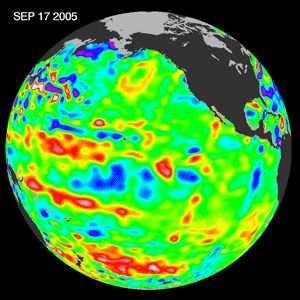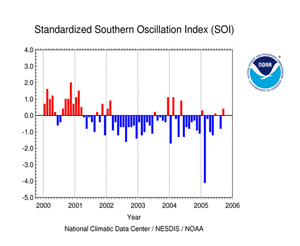SSTs COOL AS THE NEUTRAL PHASE OF ENSO PERSISTS
|
|
Sea-Surface
Temperatures (SSTs) and
Mixed-Layer Conditions: Over the past month, SSTs across the equatorial Pacific Ocean have continued to cool or remain near-normal. The coldest anomalies have persisted along the South American coast, as reflected in the SST observations from the Niño 1+2 region during September. Temperatures in the upper ocean and mixed-layer have also decreased, as a layer of anomalously cold water (~1-2°C or ~2-3.5 °F below normal) persisted at 50-200 m depth in the equatorial Pacific. For the month, the September SST anomaly was -0.18°C (-0.32°F) below average in the Niño 3.4 Index region in the central equatorial Pacific Ocean, and +0.09°C (+0.16°F) above the mean in the Niño 4 Index region in the western equatorial Pacific Ocean (map of Niño regions). For the most recent ocean surface temperature conditions, please see the loop of satellite-derived weekly SST anomalies for September 2005. In early 2005, ocean surface and subsurface temperatures began to cool in the equatorial Pacific basin. As a result, the monthly SST anomalies in the Niño 3.4 region exceeded +0.5°C only during April of this year, after which the 2004-2005 ENSO warm event dissipated. At the end of September 2005, the 3-month running mean of the Niño 3.4 Index continued to decline sharply and was was approaching zero. (NOTE: A running 3-month mean SST anomaly above +0.5°C in the Niño 3.4 region is one indicator that an El Niño is occurring. For the official NOAA classification scheme, please see NOAA's El Niño/La Niña Index Definition and see the CPC ENSO Diagnostic Discussion for NOAA's latest official assessment of ENSO conditions.) |
|
|
Equatorial
Zonal Winds (U-Component Winds) and Sea-Level
Topography: The easterly trade winds were above-normal during September across the eastern and central tropical Pacific basin, which helped to enhance equatorial upwelling in the mixed-layer. In the western equatorial Pacific basin, westerly wind anomalies developed during the latter half of the month and these moved east past the dateline by mid-September (see the September zonal wind loop). Satellite altimetry of ocean surface topography from the NASA/JPL Jason-1 satellite over the Pacific basin and global oceans is shown to the left. The overpass of the Jason-1 satellite on September 17th showed that increased sea level associated with tropical convection developed near the equator in the western Pacific near the end of the month. This was the first significant sea level rise since late April, but it remains uncertain whether this event generated an oceanic Kelvin wave and whether it will persist and move further eastward. |
|
|
Outgoing
Longwave Radiation (OLR): The map to the left shows the spatial pattern of global OLR (in W m-2) observed by satellite during September. No large-scale OLR anomalies were observed along the equatorial region in the tropical Pacific, except for a region of negative OLR anomalies associated with enhanced convection and tropical cyclone activity west of the dateline. The 3-month averaged OLR anomalies during the July-September period show that positive OLR anomalies were present just north of the equator in the central and eastern Pacific basin, and therefore tropical convection was suppressed along the Inter-Tropical Convergence Zone (ITCZ). The monthly averaged OLR Index remained postive in September, with a mean value of +0.1 averaged across an area centered over the dateline in the western Pacific (between 160° E and 160° W). The OLR Index has shifted sign several times over the past year, with no persistent trend in the index observed so far in 2005. Note that high frequency variability in OLR is typically associated with the Madden-Julian Oscillation (MJO) (MJO related convective activity propagates west to east in the near-equatorial region from the Indian Ocean into the Pacific Ocean approximately every 30-60 days). The latest MJO activity can be seen in CPC's graphs of Daily MJO Indices. |
| Southern
Oscillation Index (SOI): The standardized SOI remained near-neutral in September, despite a slight increase in the monthly averaged index to a value of +0.4. The SOI has been negative during 5 months so far in 2005, with an extraordinarily low value of -4.1 occurring back in February 2005 (which was the lowest SOI value since the peak of the 1982-1983 El Niño event). However, since March the SOI has been either neutral or near-neutral, which reflects the lack of any large-scale fluctuations in mean sea-level pressure (MSLP) across the tropical Pacific basin. |
Additional Links
- ENSO Monitoring
- NOAA El Niño / La Niña Index Definition
- NOAA's Pacific Marine Environmental Laboratory (PMEL):
- NOAA's Climate Prediction Center (CPC):
- NOAA's Physical Science Laboratory
- NASA/JPL Ocean Surface Topography from Space
- Australian Bureau of Meteorology (BoM) Climate Driver Update
- IRI - International Research Institute
 NOAA's National Centers for Environmental Information
NOAA's National Centers for Environmental Information









